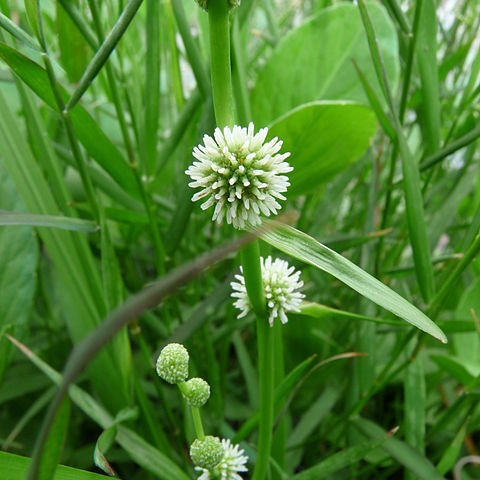Stems 16-130 cm high including inflorescence. Basal leaves erect, sometimes floating, 37-100 cm long, usually 1.5-4.5 mm wide, rarely to 9 mm wide. Inflorescence simple or with 1-3 branches and then the terminal branch extending well above the lower ones. Male heads 8-15 mm wide at maturity, 3-12 per branch. Female heads usually 15-20 mm wide in fruit (including beaks), rarely to 23 mm wide, 1-5 per branch, each subtended by a leaf-like bract. Perianth segments around fruit usually widest near middle, thickened or remaining papery above, obtuse to rounded. Anthers 0.5-1 mm long. Fruits 4-6.5 mm long, 1.5-3 mm wide, obovate to fusiform, sometimes constricted above middle, smooth to slightly ridged; ridges longitudinal, few.
Basal leaves usually exceeding the inflorescence, (1-)2-4(-9) mm wide. Lowermost bract up to 15 cm long, 0.5-1 (rarely more) times as long as the inflorescence. Female heads solitary, axillary or on lateral branches, occasionally one head supra-axillary, sessile, rarely with an up to 5 mm long peduncle. Male heads solitary. Female flowers: perianth segments free, in fruit 0.3-0.5 times as long as the fruit; pedicel 0-1 mm long. Male flowers: filaments 2.5-3.2(-3.8) mm long, anthers 0.5-0.9 (-1) mm long. Fruits obovoid to almost globose, yellowish to pale brown, shiny, subsessile or with an up to 1 mm long, not persistent pedicel. Endocarp 1.6-1.8 mm wide.
Stems erect, 20-36 cm tall, slender. Leaves 25-35 cm × 2-3 mm, upper flattened, lower keeled or trigonous on abaxial side. Panicles 7-15 cm, main axis consisting of 5-7 male heads and 2 or 3 female heads, usually with 1 lateral branch at base; lateral branch 5-8 cm, with 2 or 3 male and 1 or 2 female heads. Male flowers: perianth segments spatulate, ca. 2 mm, lobate at apex; filaments ca. 2 mm; anthers oblong, ca. 1 × 0.3 mm. Female flowers: perianth segments spatulate, ca. 2 mm, lobate at apex; ovary sessile; styles ca. 0.5 mm; stigmas unilateral, ca. 1.5 mm. Fruit obovoid, ca. 4 mm. Fl. and fr. Jun-Sep.


